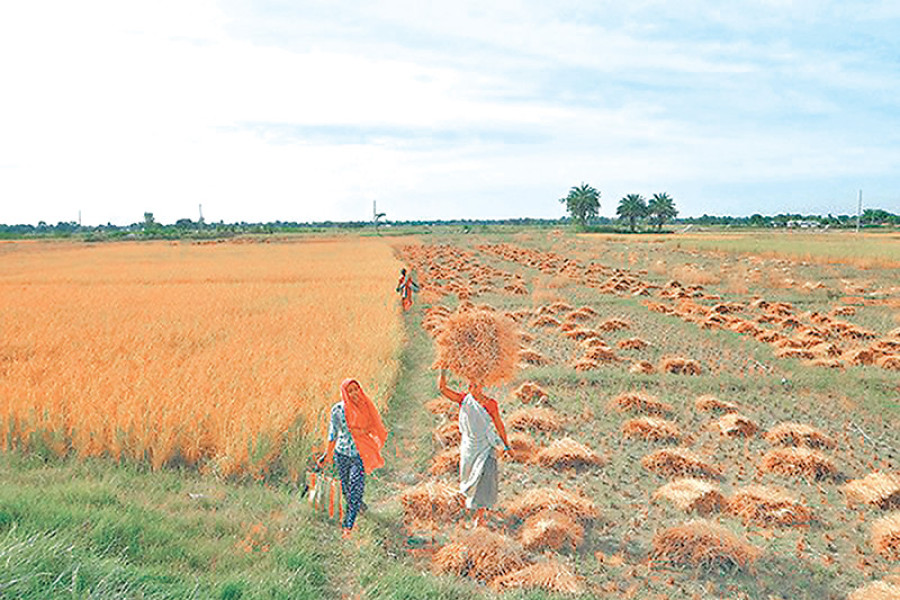Money
Jhapa’s paddy super zone output less than stellar
Paddy production in Jhapa district’s paddy super zone and paddy block failed to meet expectations of many due to low soil quality, floods and lack of rain during the plantation season.
Arjun Rajbansi
Paddy production in Jhapa district’s paddy super zone and paddy block failed to meet expectations of many due to low soil quality, floods and lack of rain during the plantation season.
The government had formed the paddy super zone and paddy block in Jhapa to raise production and productivity of paddy. It is part of the Prime Minister Agricultural Modernisation Project, which was introduced around two and a half years
ago, to commercialise agriculture and promote mechanisation in the agricultural sector. In a bid to roll out this project, the government has formed super zones, zones, blocks and pockets in various parts of the country to promote production of fishes and various cereal crops, vegetables and fruits.
As per this plan, a super zone and a block have been created in Jhapa to increase production and productivity of paddy.
The super zone command area in Jhapa is made up of 1,000 hectares of land, while the block constitutes 85 hectares of land. The combined acreage of the paddy super zone and block is about 1 percent of the total acreage of the entire Jhapa district.
The government is yet to collect data on production of paddy in the super zone and block of Jhapa. But many farmers and experts told the Post that paddy production in these designated areas is not satisfactory, as the super zone and block lack access to irrigation facilities. The paddy super zone was implemented in Kachankawal rural municipality and the paddy block in Gauradaha municipality. The chairman of District Agricultural Development Office Prakash Dangi said that the production increase did not materialise because of low quality of soil, flood damage, and uneventful rain. He mentioned that despite the stagnating production in the first year of implementing the super zone and block, there is no reason for pessimism since production is likely to rise starting the second year. He also claimed that all stakeholders, including farmers, should be duly diligent in their duties for the production to increase.
In previous years, majority of farmers planted Ranjit Mansuli and Sarna category of seeds, which perversely affected soil’s quality. The level of production also depends on whether the seed planted previously deteriorates soil condition. Officer Timilsina said,” These variants of paddy diminish productivity capacity of soil. We have avoided planting these kinds of paddy. This has been the reason for the normal production this year.” Paddy seeds planted in Jhapa Super Zone were Swarna Sub Ban, Garima, Mahima, Makwanpur Ban, Radha 4, Radha 14. Experts attest to the excess acidity of the district’s soil, with 97.28 percent of the soil in the district categorised as acidic. Under the leadership of senior Soil Expert at Soil Management Directory Kathmandu, the team of soil experts at Regional Soil Inspection Lab at Jhumka Sunsari and Soil Inspection Lab at Surunga Jhapa tested soil in the super zone. Sample tests of soil at 219 sites demonstrated excess soil acidity.
During soil inspection, experts identified 2.28 percent of the soil as neutral. Such soil generates minimal production of nutrients needed for the crop as bacteria that rot organic matter are not present in neutral soil. Senior Officer Timilsina said that opting for chemical fertiliser instead of manure and organic fertiliser further exacerbated the soil’s acidity level.
To remove the soil’s acidity and to expedite productive capacity, agricultural lime was used in the super zone. The office has facilitated a 50 percent grant for agricultural lime and its transportation for areas based in the super zone.
For plantation of monsoon rice, 50 kg of agricultural lime per kattha (1 kattha being equivalent to 0.0338 hectare) was employed. Dhaicha and Sanahi fertilisers prevailed over chemical fertilisers. “This year we paid special attention to optimise soil productivity. This has caused the soil condition to improve significantly. We believe that production of all crops in the super zone will surge starting next year,” added Timilsina.
Bedhniki Chapagain, Secretary of Paddy Block Conducting Committee in Gauradaha, also substantiated that this year’s rice production is barely on par with production in previous years. He mentioned that even if an increase in paddy production did not materialise as expected, he learned relevant technical issues. Maharanijhoda Small Farmers Agricultural Cooperative has been operating Jhapa’s paddy block.
The whole district saw 0.11 percent rise in paddy production. Rice was cultivated in 85,500 hectares this year and paddy production stood at 410,400 metric tonnes. Last year, paddy was planted on 87,500 hectares of land, from which 410,375 metric tonnes of paddy was produced.




 9.12°C Kathmandu
9.12°C Kathmandu














